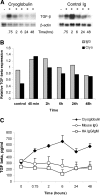Protease nexin-1, tPA, and PAI-1 are upregulated in cryoglobulinemic membranoproliferative glomerulonephritis
- PMID: 18199802
- PMCID: PMC2396743
- DOI: 10.1681/ASN.2007030367
Protease nexin-1, tPA, and PAI-1 are upregulated in cryoglobulinemic membranoproliferative glomerulonephritis
Abstract
Thymic stromal lymphopoietin (TSLP) transgenic mice develop cryoglobulin-associated membranoproliferative glomerulonephritis, characterized by renal monocyte/macrophage infiltration, marked expansion of extracellular matrix, and variable intraluminal and mesangial deposits of cryoglobulins. A microarray approach was used to study global gene expression in glomerular RNA obtained from these mice, as well as from combined TSLP transgenic and Fcγ receptor IIb null mice (TSLP/FcIIb−/−), which develop aggravated membranoproliferative glomerulonephritis. Protease nexin-1 (PN-1) and tissue plasminogen activator (tPA), two potential regulators of fibrosis that are involved in the fibrinolytic and coagulation pathways, were dramatically upregulated in TSLP mice compared with wild-type controls. In situ hybridization revealed minimal expression of PN-1 mRNA in the glomeruli of wild-type mice, increased expression in TSLP mice, and the greatest expression in the mesangial cells of TSLP/FcIIb−/− mice. Immunohistochemistry demonstrated greater expression of PN-1, tPA, and PAI-1 in the mesangial cells of TSLP mice compared with wild-type and the greatest in TSLP/FcIIb−/− mice. In cultured mesangial cells, incubation with cryoglobulins induced an upregulation of PN-1 mRNA; increased expression of PN-1, tPA, and PAI-1 proteins; and stimulated secretion of TGF-β1. It is concluded that PN-1, tPA, PAI-1, and TGF-β1 are likely important mediators of murine cryoglobulinemic glomerulonephritis and that the cryoglobulins may directly upregulate their expression.
Figures






Similar articles
-
Cryoglobulinemic glomerulonephritis in thymic stromal lymphopoietin transgenic mice.Am J Pathol. 2001 Dec;159(6):2355-69. doi: 10.1016/S0002-9440(10)63085-4. Am J Pathol. 2001. PMID: 11733384 Free PMC article.
-
Expression of glomerular plasminogen activator inhibitor type 1 in glomerulonephritis.Am J Kidney Dis. 2002 Apr;39(4):695-705. doi: 10.1053/ajkd.2002.31986. Am J Kidney Dis. 2002. PMID: 11920334
-
Monocyte recruitment in cryoglobulinemic membranoproliferative glomerulonephritis: a pathogenetic role for monocyte chemotactic peptide-1.Kidney Int. 1997 Jan;51(1):155-63. doi: 10.1038/ki.1997.19. Kidney Int. 1997. PMID: 8995729
-
Heat-insoluble cryoglobulin in a patient with essential type II cryoglobulinemia and cryoglobulin-occlusive membranoproliferative glomerulonephritis: case report and literature review.Clin Chim Acta. 2009 Aug;406(1-2):170-3. doi: 10.1016/j.cca.2009.05.013. Epub 2009 May 20. Clin Chim Acta. 2009. PMID: 19463798 Review.
-
[To proliferation of mesangial cells in ontogenesis].Adv Gerontol. 2010;23(3):349-56. Adv Gerontol. 2010. PMID: 21137204 Review. Russian.
Cited by
-
Serine proteases, inhibitors and receptors in renal fibrosis.Thromb Haemost. 2009 Apr;101(4):656-64. Thromb Haemost. 2009. PMID: 19350108 Free PMC article. Review.
-
Successful treatment of cryoglobulinemic glomerulonephritis derived from Waldenström's macroglobulinemia by rituximab-CHOP and tandem high-dose chemotherapy with autologous peripheral blood stem cell transplantation.Int J Hematol. 2010 Sep;92(2):391-7. doi: 10.1007/s12185-010-0638-1. Epub 2010 Aug 5. Int J Hematol. 2010. PMID: 20686877
-
Genetic Association of Hepatitis C-Related Mixed Cryoglobulinemia: A 10-Year Prospective Study of Asians Treated with Antivirals.Viruses. 2021 Mar 11;13(3):464. doi: 10.3390/v13030464. Viruses. 2021. PMID: 33799903 Free PMC article.
-
Application of long-acting VLHL PAI-1 during sutureless partial nephrectomy in mice reduces bleeding.Biomed Res Int. 2015;2015:392862. doi: 10.1155/2015/392862. Epub 2015 Mar 26. Biomed Res Int. 2015. PMID: 25883959 Free PMC article.
-
Reversibility of structural and functional damage in a model of advanced diabetic nephropathy.J Am Soc Nephrol. 2013 Jun;24(7):1088-102. doi: 10.1681/ASN.2012050445. Epub 2013 May 2. J Am Soc Nephrol. 2013. PMID: 23641056 Free PMC article.
References
-
- Huang Y, Noble N: An unexpected role of plasminogen activator inhibitor-type 1 (PAI-1) in renal fibrosis. Kidney Int 67: 2502–2503, 2005 - PubMed
-
- Eddy AA: Plasminogen activator inhibitor-1 and the kidney. Am J Physiol Renal Physiol 283: F209–F220, 2002 - PubMed
-
- Feng L, Tang WW, Loskutoff DJ, Wilson CB: Dysfunction of glomerular fibrinolysis in experimental antiglomerular basement membrane antibody glomerulonephritis. J Am Soc Nephrol 3: 1753–1764, 1993 - PubMed
-
- Malliaros J, Holdsworth SR, Wojta J, Erlich J, Tipping PG: Glomerular fibrinolytic activity in anti-GBM glomerulonephritis in rabbits. Kidney Int 44: 557–564, 1993 - PubMed
Publication types
MeSH terms
Substances
Grants and funding
LinkOut - more resources
Full Text Sources
Other Literature Sources
Molecular Biology Databases
Miscellaneous

